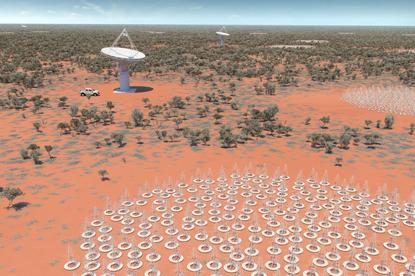CSIRO and Aurecon plan to lay 65k fibre cables for SKA telescope
- 26 February, 2019 10:46

An artist’s impression of the future SKA antennas.
The Australian component of the world’s largest radio telescope will require 65,000 optical fibre cables to transport the vast quantities of data it will generate.
The Square Kilometre Array (SKA) will be sited in both Australia and South Africa, with two separate consortia tasked with building out local infrastructure in the host nations. The two SKA teams — Infrastructure Australia (INAU) and Infrastructure South Africa (INSA) — have formally completed their design work, the SKA Organisation has announced.
The SKA project is also supported by Canada, China, France, India, Italy, the Netherlands, New Zealand, Spain, Sweden and the UK.
“This is the culmination of many years of development on both sites in preparation for the start of construction of the SKA,” said the organisation’s head of planning, Gary Davis. “Both consortia have done a stellar job in collaboration with one another to design the crucial infrastructure that’ll support the SKA,” Davis said in a statement.
In Australia, the INAU team was led by the CSIRO. Data from 132,000 low-frequency SKA antennas will eventually be fed into the CSIRO’s Murchison Radio-astronomy Observatory (MRO) in WA. The Australian component of SKA is known as ‘Ska-Low’, while South Africa hosts the mid-frequency ‘Ska-Mid’.
“The data flows will be on the scale of petabits, or a million billion bits, per second – more than the global Internet rate today, all flowing into a single building in the Murchison,” said the CSIRO's SKA infrastructure consortium director, Antony Schinckel.
The CSIRO worked with engineers from Aurecon on infrastructure design.
To help minimise radio noise, the federal and WA governments have declared a radio quiet zone in a 520-kilometre diameter area around the MRO. The need to minimise potential radio interference extends to the infrastructure that will gather and process SKA data.
“Containing the interference created by our own computing and power systems is an unusual construction requirement,” said to Aurecon senior project engineer, Shandip Abeywickrema.
"We're trying to reduce the level of radio emissions by factors of billions.
“For example, the custom supercomputing building is effectively a fully welded box within a box, with the computing equipment to be located within the inner shield, while support plant equipment will be located in the outer shield.”
SKA construction work is expected to kick off in 2020.
